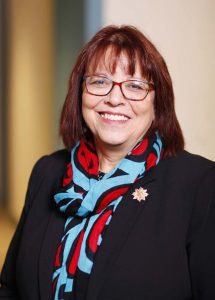Higher education leaders can take cues from Tribal colleges and universities (TCUs) to better support Native American students, according to a research brief published by the Penn Center for Minority Serving Institutions (CMSI) at the University of Pennsylvania.
 Rachel Bryan
Rachel BryanThe brief “Native American Student Success: The Effect of Tribal Colleges and Universities on Native American Student Retention” examines the culturally relevant experience offered at TCUs and ways for mainstream institutions to establish partnerships for Native student success.
“By attending a Tribal college or university, Native American students are four times more likely to receive their bachelor’s degree than their peers that attend a mainstream four-year institution immediately after high school,” Rachel Bryan, a CMSI research assistant and graduate intern for the Office of Multi-Ethnic Student Affairs at the University of Michigan, wrote in the brief. “TCUs understand the needs and values of their student population and provide resources specific to those needs.”
TCUs incorporate Native American values, tribal languages and tribal history into their curriculum and support structures, offering students an education and a community, the report said.
Native students’ relationship with the faculty and staff at TCUs similarly plays a significant factor in their success outcomes. TCU faculty and staff serve as tutors, advisors or even “follow-through” mentors for those students who have an interest in transferring to a mainstream four-year institution. These individuals are “present in many aspects of students’ lives,” the report added.
Alternatively at mainstream institutions, Bryan notes that Native students are exposed to a Eurocentric curriculum and often experience “isolation, hostility and racism” from classmates and professors. This can contribute to their low retention rates and a negative experience on campus.
Students “often feel very invisible, not just in the climate of the college, but also in the representation that exists,” said Dr. Cheryl Crazy Bull, president and CEO of the American Indian College Fund. “They don’t see themselves reflected in the curriculum. They don’t see themselves reflected in the images the institution has unless there’s a deliberate effort on the part of the institution.”
If mainstream institutions do provide specific supports to Native students, they can help advance their retention and eventual graduation, but those support services are still limited, Crazy Bull said.
Any partnerships between TCUs and mainstream institutions should ensure that the relationship is a mutually beneficial agreement.
“A lot of [mainstream four-year institutions] have tried to dominate the partnership,” said Bryan. But it is important for the institutions to recognize that TCUs have “authority and knowledge” on how to support their students.
The report lists several examples of TCU-mainstream partnerships. There is the All Nations Louis Stokes Alliance for Minority Participation funded by the National Science Foundation that brought together 27 TCUs and 11 four-year institutions.
Other partnerships include ones between Diné College and Arizona State University; Sinte Gleska University, Leech Lake Tribal College and Bemidji State University; and Montana State University-Bozeman and Little Big Horn College, Fort Peck Community College, Stone Child College and Chief Dull Knife College.
On their own campuses, Bryan said mainstream four-year schools can provide resources on Native American transfer experiences specifically from Native scholars, increase their TCU outreach, create and support Native student organizations and promote Native students’ history and culture on campus.
 Dr. Cheryl Crazy Bull
Dr. Cheryl Crazy BullThese efforts can show that the Native community is “present and active,” Bryan said, and help others learn more and understand issues around Native students’ experiences and educational attainment.
“People will relegate us to that small population,” often prompting researchers and scholars to say that Native students are the “asterisk at the bottom of [data] table,” Crazy Bull said.
“Part of our equity advocacy is to say that if you have even one student, you should know what’s going on with that one student,” she urged. “You can’t close that [degree completion] gap without increased investment and increased visibility.”
Tiffany Pennamon can be reached at [email protected]. You can follow her on Twitter @tiffanypennamon.



















